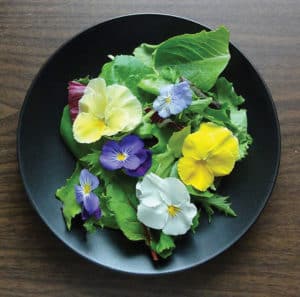By Andrea Knepper
Like me, you are probably getting ready to go to the local garden center and pick up some annual flowers to spruce up your landscaping. This year, consider planting some edible annuals instead.
The idea of incorporating edible plants into landscaping has grown in popularity in recent years. Increasing the diversity in your yard can provide habitat for pollinators, add variety to traditional landscaping choices and create visual interest in your yard. In addition, these will add a new element to your cooking.

Pansies make a colorful and delicious addition to summer salads.
Buy organic if possible to ensure that no pesticides were used. Avoid spraying with chemicals while growing these in your gardens. Keep in mind when incorporating edible plants that you may garner interest from local wildlife.
Harvest flowers when fully bloomed but before they begin to wilt. Use sharp scissors and cut during early morning or evening hours when it is cooler. Blooms will stay fresh for a few days if refrigerated.
When adding edible flowers to your landscape, consider nasturtiums, which come in several colors ranging from red and orange to yellow. A trailing variety acts as a ground cover when carefully draped among other landscaping plants. Both the leaves and flowers are edible and have a peppery taste.
The seeds also are safe to consume. When still green, they can be pickled and used like capers. Dried, they can be ground and used as a pepper substitute.
Swiss chard interplanted with nasturtiums will add interest to your landscape. The stems come in many vibrant colors, adding a burst of color throughout the fall. You can direct sow seed or plant starts, if available where you purchase plants. Careful harvesting will leave chard looking attractive throughout the season.
Both the petals and leaves of calendula are edible. Try adding the leaves to salads for a tangy or slightly bitter element. The vibrantly colored petals can be used as garnish or as a coloring agent like saffron. Petals can be dried for later use in tea. Calendula blossoms are available in eye-catching colors. One will surely fit your landscaping color palette.
Perhaps pansies already play a part in your summer landscaping. Pansy petals make a beautiful addition to salads. They are a perfect choice for candying and decorating desserts because the whole flower can be used.
Try freezing pansies into ice cubes. The refreshing, mild wintergreen flavor will be a welcome addition to lemonade on a hot summer day.
For a colorful choice for vertical interest, perhaps against a wall or arbor, consider scarlet runner beans. The lush, green foliage provides a backdrop to the vibrant flowers, which are edible and in shades of red and pink. The red flowering varieties are especially attractive to hummingbirds.
Although considered an ornamental, the bean pods can be eaten. To eat fresh, harvest the pods before beans form as they can become tough. After beans form, they can be shelled for fresh eating or allowed to dry in the pod.
Herbs are a nice choice to tuck into spots that might be a bit shady or a bit wet or too sunny for other plants. Borage has attractive, star-shaped flowers that pollinators love. The edible blue flowers have a slight cucumber taste. Or plant chives. The purple blossoms make a great addition to green and pasta salads as well as dips.
When shopping for plants, take into account the same principles you would for choosing annual flowers: color, foliage, height, sun and soil requirements and spacing needs. The experts at your local garden center will be able to advise you on which edible annuals will do best at your location.
Andrea Knepper is a UVM Extension master gardener intern from Bolton.




